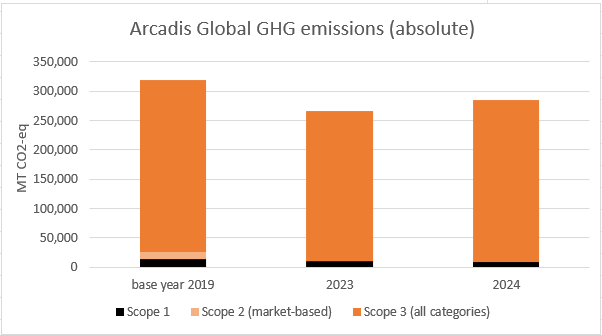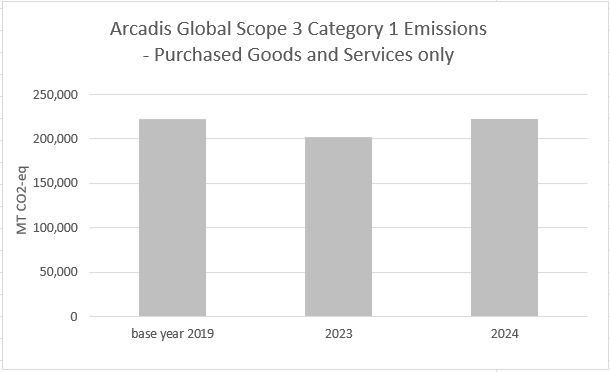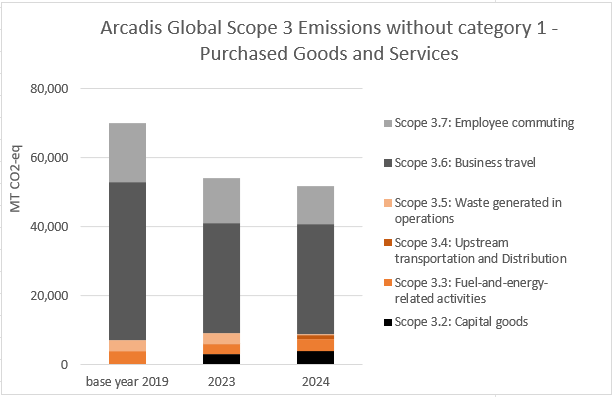Climate change is the paramount challenge of our era, with the built environment contributing nearly 40% of global emissions. Addressing this sector is crucial for mitigating climate change and enhancing resilience against extreme events. We are uniquely positioned to reshape the built environment for future generations.
At Arcadis, we actively drive the shift to a low-carbon economy through extensive greenhouse gas reduction initiatives. We continuously redefine our client engagements, products and services to align with a 1.5° world, positively impacting the built environment with lasting effects.

Our Climate Transition Plan (CTP) outlines our commitment to meeting climate goals and promoting a planet-positive future through sustainable project choices. Our CTP includes initiatives such as renewable energy procurement, fleet electrification, sustainable travel policies, and employee commuting programs. Arcadis is also pleased to present an executive summary of our CTP. This summary highlights critical sections of the CTP and provides an accessible narrative for non-technical readers, emphasizing actionable steps, timelines, and measurable outcomes to convey our commitment to addressing climate change.
Our 2024 Carbon Footprint and Net Zero Commitment
As a supporter of the Paris Agreement and Glasgow Accords, Arcadis has, since February 2022, had a target approved by the Science Based Target initiative (SBTi) for its global scope 1, 2, and 3 emissions, aligned with a 1.5°C pathway and a net-zero commitment. Since then, we publicly announced near-term and net-zero targets in line with the new SBTi Net-Zero Standard. In 2024, these targets were approved by SBTi and now form part of our 2024-2026 strategy.
By 2035, we have committed to achieving net zero across our value chain. Our near-term objectives include reducing absolute scope 1 and market-based scope 2 GHG emissions of 70% by 2026 from a 2019 base year (2024 progress: −66%) and reducing absolute scope 3 GHG emissions of 45% by 2029 from a 2019 base year (2024 progress: −6%).
We have implemented some notable strategies to help achieve these targets. These include committing to transitioning our entire company fleet to electric vehicles (EVs) by 2030. By the end of 2024, 35% of our vehicles were EVs. We have also committed to reducing emissions from air travel by 50% (2024 progress: −20%) and from business travel by 35% (2024 progress: −30%) by 2025, compared with our 2019 baseline.
Arcadis achieved an 11% absolute reduction across scope 1, 2, and 3 GHG emissions from 2019 to 2024.
Over the same period, we reduced scope 1 and market-based scope 2 emissions by 66% driven by efforts to consolidate office spaces and transition to renewable electricity. By leveraging direct contracts and renewable electricity certificates, we achieved an approximate 50% reduction in combined scope 1 and 2 emissions. As we plan future office relocations we will continue to prioritize renewable energy sources to further reduce our emissions.
Our total scope 3 emissions (upstream relevant categories) were 8% higher than in 2023 but remained approximately 6% below our base year level. The year-on-year increase was driven primarily by an 11% rise in our category 1 emissions (purchased goods and services).
Employee commuting emissions decreased slightly, reflecting fewer employees in certain geographies with high commuting emissions per headcount, the consolidation of US offices, and temporary closures of some German offices during renovations.
We updated our methodology for calculating our business travel emissions (see Glossary in Arcadis’ Annual Integrated Report 2024). The impact on 2019 and 2023 figures was less than our 5% threshold for total GHG emissions, so no restatement of prior-year values was required. Consequently, year-on-year business travel emissions did not change significantly.
Category 5 emissions (waste generated in operations) decreased due to improved data quality: in 2024 we began collecting actual waste data (see Glossary in Arcadis’ Annual Integrated Report 2024), replacing estimates. The resulting change to 2019 and 2023 figures was also below the 5% threshold, so prior-year values were not restated.
The GHG Protocol requires restating emissions for structural and methodological changes to ensure accurate tracking over time. For more information see GHG Protocol Corporate Standard Chapter 5: Tracking Emissions Over Time.
Table 1 : Arcadis Global Carbon Footprint in MT CO2eq (MT = metric tons)
Absolute values are rounded to 10; and in scope 3 to 100 or 1000| Absolute GHG emissions (MT CO2e) | base year 2019 | 20234 | 2024 |
| Scope 1 | 13,290 | 10,140 | 8,690 |
| Scope 2 (market-based) | 12,900 | 710 | 280 |
| Scope 2 (location-based) | 17,320 | 9,680 | 9,370 |
| Scope 3 (all categories)1 | 292,000 | 256,000 | 275,800 |
| Scope 3.1: Purchased goods & services | 222,000 | 202,000 | 223,400 |
| Scope 3.2: Capital goods | Included in cat 1 | 3,000 | 3,900 |
| Scope 3.3: Fuel-and-energy-related activities | 4,000 | 3,000 | 3,500 |
| Scope 3.4:Upstream transportation and Distribution2 | Included in cat 1 | 1 | 1,100 |
| Scope 3.5: Waste generated in operations | 3,000 | 3,000 | 200 |
| Scope 3.6: Business travel | 46,000 | 32,000 | 32,300 |
| Scope 3.6 - Air Travel only (included in Scope 3.6 Business Travel) | 31,000 | 23,000 | 25,000 |
| Scope 3.7: Employee commuting | 17,000 | 13,000 | 11,400 |
| Total Absolute Footprint (all scopes, market-based)3 | 318,000 | 267,000 | 284,770 |
| Total Footprint (all scopes, location-based)3 | 323,000 | 276,000 | 293,860 |
| Scope 3 (other) : Working from home | 3,000 | 13,000 | 15,900 |
| Relative GHG emissions (MT CO2e/FTE) | base year 2019 | 20234 | 2024 |
| Scope 1 + 2 (market-based) / FTE | 0.98 | 0.32 | 0.26 |
| Scope 1 / FTE | 0.50 | 0.30 | 0.25 |
| Scope 2 (market-based) / FTE | 0.481 | 0.021 | 0.008 |
| Scope 3 / FTE | 10.9 | 7.5 | 8.1 |
| Scope 3.6: Business travel / FTE | 1.71 | 0.93 | 0.94 |
| Scope 3.6 - Air Travel only / FTE | 1.16 | 0.67 | 0.72 |
| Total relative Arcadis Footprint (all scopes, market-based) | 11.9 | 7.8 | 8.3 |
1 Scope 3 categories 8-15 are not relevant or not material for Arcadis. Category 15 emissions are excluded as they're not part of Arcadis' target boundary (we have still calculated estimated the emissions for this category, and it would be 6 tCO2e for 2024).
2 Upstream transportation and distribution was included within scope 3 category 1 prior to 2024; therefore no comparison can be made between 2023 and 2024.
3 We keep working from home-related emissions separate from our total GHG emissions to align with the requirement for our SBTi net zero targets.
4 Our 2023 values for scope 3 category 1 have been adjusted following updated acquisition emissions estimates. We changed our FTE-based intensity estimation method to a revenue-based estimate approach. The value for 2019 stays the same as the change due to this method update is below our threshold of 5% of the total corporate-wide GHG emission inventory relative to our previously reported value.
To support our net zero transition, we are taking a prioritized approach to addressing the key sources of emissions, particularly in areas such as purchased goods and services, underpinned by improving data quality. For each scope of emissions, we are implementing targeted reduction measures.
For scope 1 and 2 emissions, initiatives include transitioning our fleet to EVs, routinely incorporating green clauses in our leases, and, where possible, prioritizing office properties with third-party sustainability accreditations (e.g., LEED, BREEAM).
For scope 3 emissions, we have introduced carbon travel budgets, implementing more globally consistent waste reduction and recycling programs, and are collaborating with suppliers through a third-party program to reduce emissions.
Since 2010, we have reported our global emissions and energy consumption in accordance with the Greenhouse Gas (GHG) Protocol. Our carbon footprint has received limited assurance from our external auditor as outlined in our Annual Integrated Report for 2024 (page 328).
The figures below show our reported emissions, in metric tons of CO2-equivalent (MT CO2-eq) for our baseline year (2019) compared to the last two years, including 2024.

Figure 1: Arcadis Global GHG emissions (absolute)

Figure 2: Scope 3 Category 1 - Purchased Goods and Services only

Figure 3: Scope 3 without Purchased Goods and Services
The main contributor to our total carbon footprint is purchased goods and services (Scope 3 category 1; see Figure 2). Among the remaining scope 3 categories, most emissions come from business travel—our people traveling to meet with clients and work on projects—which is captured in category 6: Business travel (see Figure 3).
Our scope 1 emissions are driven primarily by the GHG emissions from company-owned or leased vehicles, and, to a smaller extent, from stationary energy use (mostly natural gas) in some of our offices.
Our location-based scope 2 emissions are dominated by electricity consumption in our offices. Our market-based scope 2 are driven mainly by district heating in some of our offices, particularly in Romania, the Netherlands, Germany, and Canada.
To reduce our market-based scope 2 emissions, we have purchased green electricity certificates (iRECs & GOs) for all offices that do not yet have direct green electricity contracts covering 100% of our office electricity consumption. We have also purchased certificates to cover electricity consumption of electric company-owned or leased vehicles, privately owned electric vehicles used for business travel, home office workstations and lighting, and electric vehicles used by employees for commuting.
Carbon Offsets
As an interim step toward net zero, we purchase high-quality carbon credits each year to match the emissions from our operations (scope 1 and 2) and selected indirect emissions (scope 3 categories 2–7). For more details, see our Annual Integrated Report on page 97 (“Beyond Value Chain”).
E1-7: Purchased Carbon credits
| 2025 | 2024 | |
| GHG emission reductions from climate mitigation projects outside value chain [MT CO2e] | 62,000 | 75,077 |
| Share of credits from reduction projects (%) | 100 | 100 |
| Share of credits from projects under quality standard Verra (VCS & CCB) (%) |
100 | 100 |
Renewable energy
In 2024, Arcadis consumed 69,401 MWh energy (combined electricity and fuels), of which 28,481 MWh (41%) was from renewable energy (Table 2). The renewable energy came primarily from purchased renewable electricity (via direct contracts and certificates), as well as from self-generated renewable electricity (0.6%), and bioethanol (1%).
Table 2: Arcadis 2024 energy consumption
| Arcadis 2024 energy consumption totals in megawatt hours (MWh) | |
| Total energy consumption (fuels and electricity) | 69,401 |
| Total energy consumption - Non-Renewable | 40,919 (59%) |
| Total energy consumption - Renewable | 28,481 (41%) |
Out of the total energy consumption, around 27,200 MWh was electricity. Of this, 17% was purchased as renewable electricity through direct contracts. For the remaining electricity consumption (83%), we purchased renewable electricity certificates in accordance with the GHG Protocol requirements for scope 2 market-based emissions accounting.
Table 3: Share of renewable electricity for offices in 2024
| Total electricity consumption | 27,200 MWh |
| Renewable electricity purchased via direct contracts and certificates | 100% |
| Renewable electricity purchased via direct contracts | 17% |
Paper consumption
In 2024, our global offices consumed 80,000 kg of paper, continuing a steady decline from previous years: 95,000 kg in 2023, 118,000 kg in 2022, and 198,000 kg in 2021. This represents a significant reduction of approximately 60% in 2024 versus 2021. In 2024, 82% of paper consumed was “sustainably sourced” (either certified by the Forest Stewardship Council (FSC) or made from 100% recycled content), up from 57.4% in 2023—an improvement of 70% year on year.
For more details on our carbon footprint methodology, refer to the glossary in our Annual Integrated Report.
Our Biodiversity Footprint
Arcadis’ biodiversity targets are aligned with the Global Goal for Nature (and the Kunming Montreal Global Biodiversity Framework, GBF). The objective of the Global Goal for Nature and the GBF is to halt and reverse nature loss by 2030. As our biodiversity targets are focused on our own operations, our internal stakeholders including employees and senior leadership, were consulted during their development.
Our targets are linked to our Biodiversity and Ecosystems Policy, which describes Arcadis’ commitment to prevent or mitigate negative impacts on biodiversity and ecosystems and contribute to their protection and restoration in its own operations through these three targets:
1. Biodiversity no net loss for all sites by 2030 (dynamic impact)
2. 10% biodiversity net gain for sites >20% green space on site by 2030 (dynamic impact)
3. By 2050, Arcadis engages to compensate for its biodiversity impact related to the cumulative land-use of its buildings (the static footprint).
Targets are compared to the 2022 baseline, which was 65.0 MSA.ha. Our targets encompass the full range of the mitigation hierarchy: avoid, minimize, restore, offset, with priority given to avoidance, minimization, and restoration of impacts over offsetting. Our key assumption in setting these targets was that we could influence the biodiversity of our office locations even though we are leasing the spaces.
A dynamic biodiversity footprint was calculated for sites that are part of Arcadis’ 2024 building portfolio as well as the 2023 building portfolio. The 2024 dynamic biodiversity footprint total is based on data for 318 sites and totals 30.10 MSA.ha. The difference compared to the 2023 static footprint (44.4 MSA.ha) is 14.34 MSA.ha (a 32% reduction), demonstrating a decrease in the impact of our own operations on biodiversity during this timeframe.
For the entire 2024 building portfolio (adding new sites, including any sites that were not part of the 2023 dataset), a new static biodiversity footprint (based on the entire 2024 portfolio of 337 sites) of 30.90 MSA.ha was calculated. This value will serve as the new baseline for next year’s biodiversity footprint calculation. Relative to the 2022 baseline, we have demonstrated no net biodiversity loss at our leased office locations and have decreased the impact of our own operations on biodiversity.
Connect for more information
We hope you enjoyed this story. It would be our pleasure to connect with you as well and discuss how we can help you improve the quality of life at your business.
